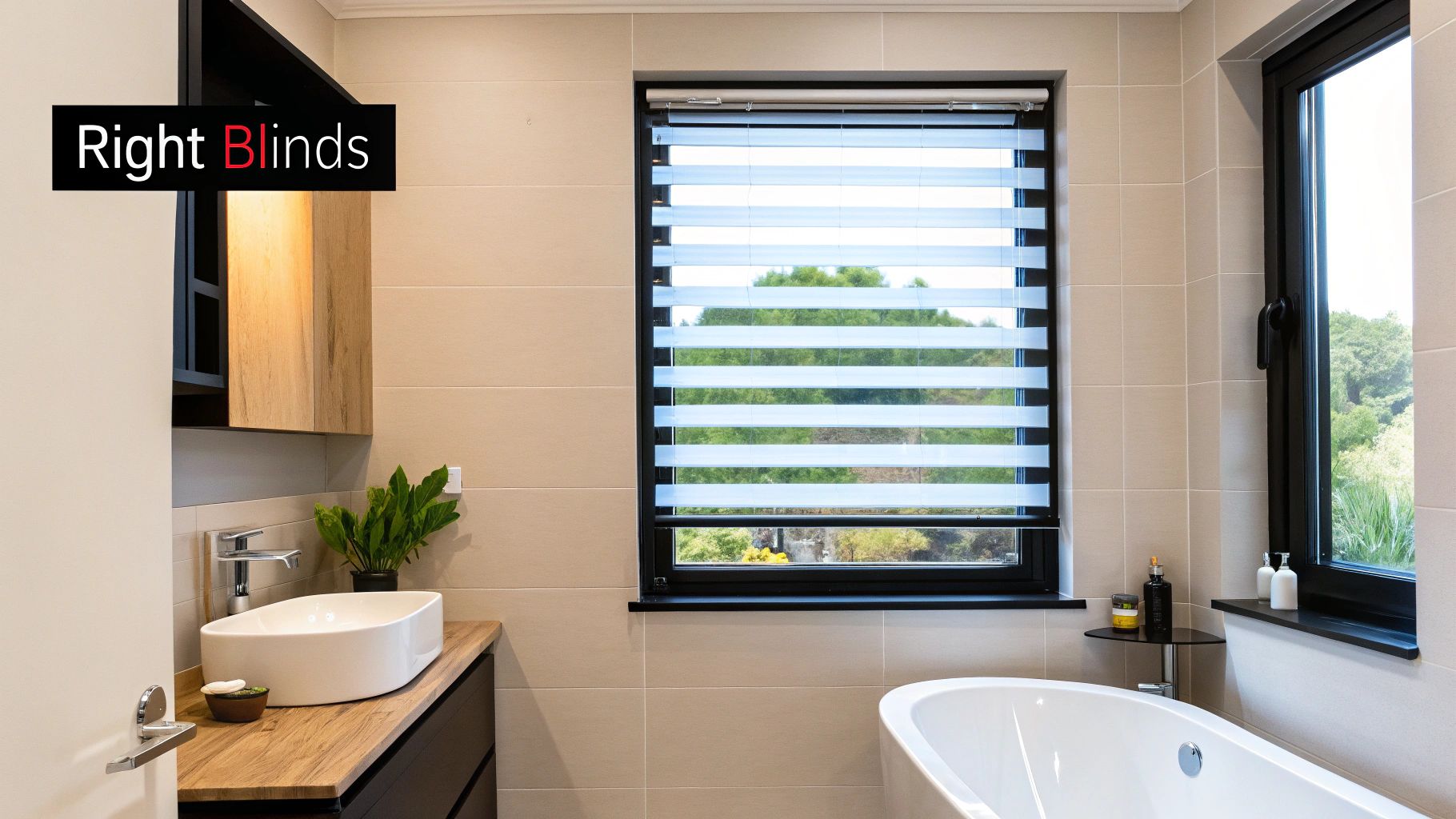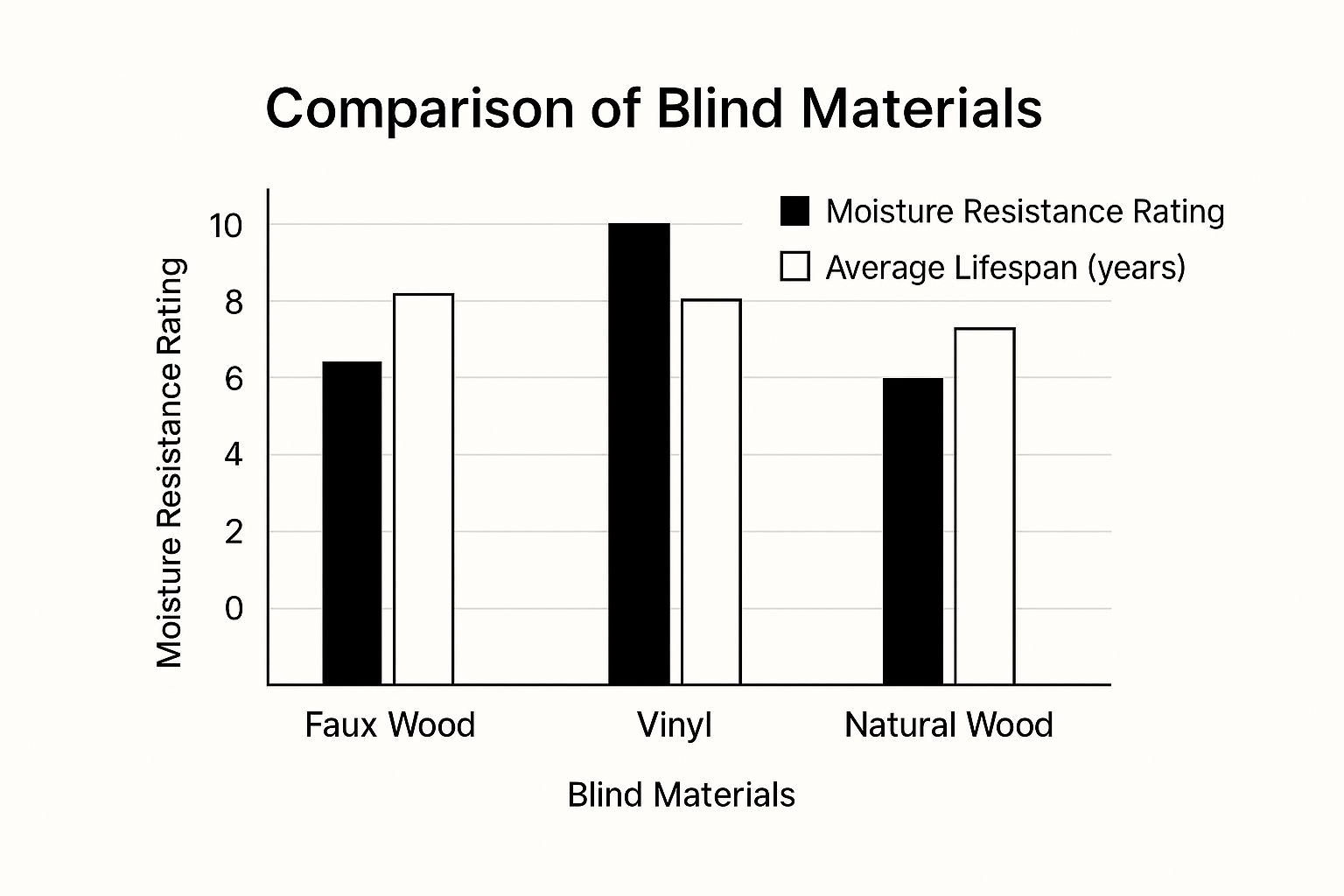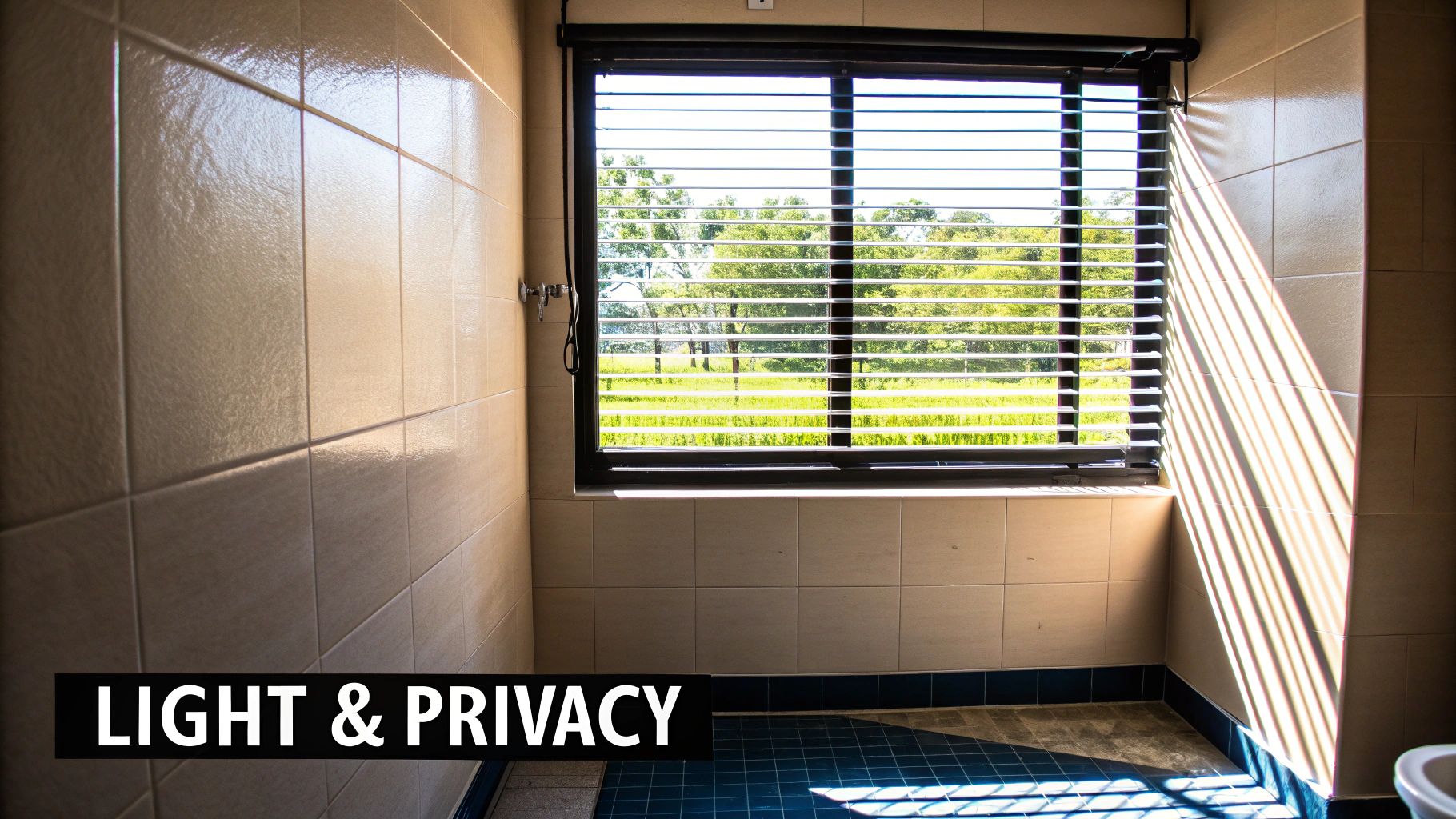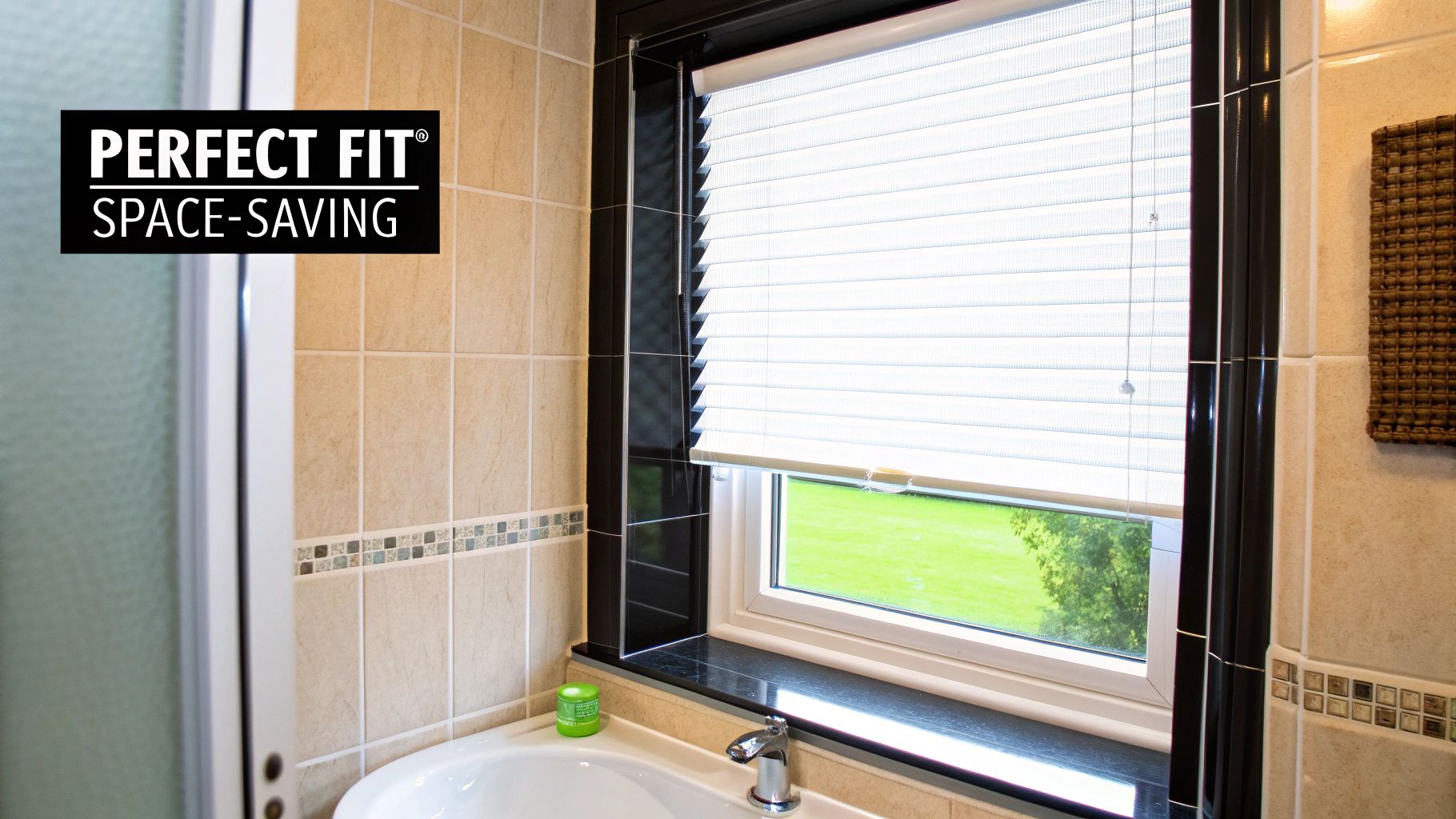Blinds for Small Bathroom Windows The Definitive Guide
- Blindsmart im
- Oct 20
- 14 min read
When it comes to picking the best blinds for small bathroom windows, your best bet is something moisture-resistant. Think faux wood or vinyl roller blinds. These options give you excellent privacy, stand up to humidity without warping, and have a slim profile that won’t clutter up your space. They’re built from the ground up to handle the unique demands of a bathroom.
Why Your Small Bathroom Window Needs a Specialist Solution

Choosing a window covering for a small bathroom goes far beyond just looks; it's a practical choice that affects the room's feel and how well it holds up over time. A standard blind, perhaps made from real wood or a delicate fabric, would be a disaster waiting to happen in a steamy bathroom. It's a bit like wearing a woolly jumper in a downpour – it’s going to soak up water, get heavy, and eventually lose its shape entirely.
This is exactly why blinds designed for damp environments are a game-changer. You can think of them as the waterproof jacket for your window. These specialist blinds are engineered to repel moisture, prevent mould from taking hold, and keep looking great day in, day out.
The Triple Challenge of Bathroom Windows
The problem gets even trickier with a small window. Whatever you choose has to nail three essential things at once:
Moisture Resistance: This is non-negotiable. The material has to be non-porous to stop it from warping, cracking, or growing mildew.
Privacy Control: Bathrooms are personal spaces. You need blinds that offer total privacy without turning the room into a dark, gloomy box.
Space Efficiency: Bulky curtains or chunky blinds can make a small bathroom feel even more cramped. The key is a sleek, minimalist design that does the job without taking over.
Recent trends in the UK back this up. We're seeing that over 40% of homeowners are putting easy-to-clean surfaces and water-resistant materials at the top of their list, which speaks directly to what a bathroom needs. It’s clear that practicality is steering people’s choices in home improvements.
At the end of the day, you're looking for a blind that works hard behind the scenes—fighting off steam and protecting your privacy—while adding a dash of style. Options like roller and Roman blinds bring different looks to the table, and figuring out what each offers is a great place to start. To dig a little deeper, have a look at our guide on Roman blinds vs roller blinds and which you should choose.
Selecting Moisture-Resistant and Durable Materials
When it comes to picking blinds for a small bathroom, choosing the right material is, without a doubt, the most critical decision you'll make. Think about it: the daily steam from showers and baths creates an incredibly humid environment. It's a bit like choosing an outfit for the weather – you wouldn't wear your best suede shoes in a downpour, and for the same reason, you shouldn't put real wood blinds in a steamy bathroom.
Materials that aren't up to the task will quickly give up the ghost. They’ll warp, crack, peel, or worse, become a perfect home for mould and mildew. This not only looks awful but can be a genuine health concern. The trick is to go for materials specifically designed to handle these damp conditions, making sure your blinds look great for years to come.
The Champions of Humidity: Faux Wood and Vinyl
In the world of blinds for small bathroom windows, two materials consistently come out on top: faux wood and vinyl. You can think of them as the all-weather gear for your windows, built to shrug off moisture without a second thought.
Faux Wood Blinds: These give you the classic, warm look of real wood but are actually made from a tough PVC composite. This material is completely waterproof, so it won’t absorb steam, swell up, or lose its shape. You get a high-end, substantial look without any of the high-maintenance drama that comes with real wood.
Vinyl Blinds: Another fantastic option, especially if you’re after a more minimalist vibe. Vinyl is 100% waterproof and an absolute doddle to clean – a quick wipe with a damp cloth is all you need to get rid of any soap scum or water spots. Their slim profile is also a huge plus in a small room, as they take up hardly any space when rolled up.
Choosing a moisture-resistant material isn't just about making your blinds last longer; it's also about hygiene. Non-porous surfaces like PVC and vinyl actively resist the growth of mould and mildew, which helps keep your bathroom a cleaner, healthier space.
This little chart breaks down how the top material choices stack up when it comes to moisture and lifespan. It’s pretty clear which ones are built for the job.

As you can see, both faux wood and vinyl are miles ahead of natural wood in terms of moisture resistance and how long they'll last in a damp bathroom.
Bathroom Blind Material Comparison
To make things even clearer, here’s a quick side-by-side comparison of the most common materials.
Material | Moisture Resistance | Durability | Ease of Cleaning | Best For |
|---|---|---|---|---|
Faux Wood | Excellent | Very High | Very Easy | The look of real wood without the worry; perfect for classic or modern styles. |
Vinyl | Excellent | High | Very Easy | Minimalist, highly functional spaces where simplicity and easy cleaning are key. |
Aluminium | Good | High | Easy | Budget-conscious projects and contemporary bathrooms, but can be noisy. |
Natural Wood | Poor | Poor (in humidity) | Difficult | Strictly for well-ventilated bathrooms that see very little steam, or other rooms. |
Fabric | Varies (Poor-Good) | Varies | Can be Difficult | Only moisture-resistant treated fabrics (like polyester) should be considered. |
Ultimately, faux wood and vinyl are the clear winners, offering the best combination of style, durability, and practicality for a typical bathroom.
Materials to Avoid in High-Moisture Areas
Knowing what works is half the battle; knowing what doesn't work can save you a lot of hassle and money. Putting up the wrong type of blind is a mistake that will quickly lead to disappointment and another shopping trip.
Here are the main materials to steer well clear of for a bathroom window:
Natural Wood Blinds: They look beautiful, there’s no denying it. But real wood is like a sponge. It soaks up moisture from the air, which will inevitably cause the slats to warp, bow, and crack.
Certain Fabrics: While some specially treated fabrics might be okay, materials like linen, silk, or untreated cotton are a recipe for disaster. They hold onto moisture, leading to musty smells, water stains, and mildew growth over time.
By sticking with proven materials like faux wood or vinyl, you can be confident your blinds for small bathroom windows will stay functional and fabulous, no matter how steamy things get.
Mastering Privacy and Light in a Small Bathroom

Getting the balance between privacy and natural light right in a small bathroom is a real art. Too much exposure and you feel on display; too little light and the room can feel like a cramped, gloomy cave. The perfect blinds for small bathroom windows are your secret weapon, acting like a dimmer switch for daylight so you can set the mood just right.
Think of your bathroom window as a tap for natural light. Some blinds are a simple on/off affair, but the best ones give you incredible control over the flow. The trick is finding a style that offers the precise level of control your space needs.
Precision Control with Venetian Blinds
When it comes to fine-tuning light, Venetian blinds are the undisputed champions. With a quick twist of the control wand, you can angle the slats to bounce light up onto the ceiling. This clever trick illuminates the entire room without giving anyone outside a direct view in.
This technique is a lifesaver for ground-floor bathrooms or any window that’s a bit overlooked. Angling the light not only protects your privacy but also makes the space feel brighter and more open. It’s a simple but incredibly effective way to manage light exactly how you want to.
The Best of Both Worlds with Flexible Styles
Sometimes, you need more than just a simple open, closed, or angled option. This is where a few innovative styles really shine, offering creative solutions for managing both daylight and privacy.
Top-Down/Bottom-Up Blinds: These are an absolute game-changer. They let you lower the blind from the top of the window, flooding the room with light while keeping the bottom half completely covered for privacy. Perfect for enjoying a bit of blue sky without feeling exposed.
Day and Night Blinds: These clever blinds feature two different fabrics on one roller – usually one sheer and one opaque. During the day, you can use the sheer layer for soft, filtered light. When you need total privacy, you simply switch to the blackout layer. If this dual-function style sounds right for you, you can learn more about how day and night blinds offer stylish light control in our detailed guide.
A common mistake is assuming you have to sacrifice a bright room for a private one. With today's blind designs, you can absolutely have both. It’s all about choosing a style that gives you the right kind of flexibility for your bathroom.
A standard roller blind in a blackout fabric, for instance, offers fantastic privacy and is ideal if you just want to block everything out. But it's an all-or-nothing solution. For a more nuanced approach, something like a Venetian or a top-down/bottom-up design will give you far more options to play with throughout the day.
How to Measure Your Small Window for a Perfect Fit
Getting the measurements right is easily the most important step when ordering blinds for small bathroom windows. A blind that doesn't fit properly won't just look a bit off; it can completely undermine your privacy and light control. It’s a bit like buying a suit off the rack versus getting one tailored – the fit is everything. A few minutes of careful measuring is all it takes to get that perfect, custom-made finish.
But before you grab a tape measure, you have one key decision to make: where exactly are you going to hang the blinds? This choice will change how you measure and the final look you'll achieve.
Recess Fit or Exact Fit: Which Is Best?
You've got two main options here, and each one creates a totally different vibe in a small bathroom.
Recess Fit (Inside Mount): This is where the blind fits snugly inside the window's recessed frame. It gives you a really clean, tidy look that’s ideal for smaller spaces, as nothing juts out into the room. It’s by far the most popular choice for bathrooms, and for good reason.
Exact Fit (Outside Mount): With this option, the blind is installed on the wall outside the recess, covering the entire window and a bit of the surrounding wall. This is a great trick for blocking out more light and can even make a small window seem bigger than it is. The trade-off is that it takes up more wall space.
Honestly, for that sleek, uncluttered feel that works so well in a compact bathroom, a recess fit is almost always the way to go.
Your Step-by-Step Measuring Guide
First things first: use a metal tape measure. The fabric or plastic ones can stretch over time and throw your numbers off. And when you measure, be precise – don't be tempted to round up or down.
For a Recess Fit (Inside Mount):
Measure the Width: Start by measuring the width inside the window recess. Do this in three places – at the top, in the middle, and at the bottom. Believe it or not, window frames are rarely perfectly square.
Record the Smallest Width: Of those three measurements, write down the narrowest one. This is your magic number. It guarantees the blind won't jam or catch on the sides as it moves.
Measure the Drop (Height): Now, do the same for the height. Measure the vertical drop from the top of the recess to the window sill on the left, in the centre, and on the right.
Record the Shortest Drop: Again, take the shortest of the three measurements. This ensures the blind hangs perfectly.
When you place your order for a recess fit, you give us these exact recess dimensions. We then handle the rest, making a tiny deduction (usually about 1cm) from the width so the blind fits and operates smoothly inside the frame.
For an Exact Fit (Outside Mount):
Measure the Width: Decide how much overlap you want on either side of the window. We suggest at least 7.5cm (3 inches) on each side for decent light blockage. So, measure the recess width, then add 15cm (6 inches) to your total.
Measure the Drop: Figure out how far above and below the window you want the blind to extend. Adding at least 7.5cm (3 inches) to the top and bottom of the recess measurement is a good rule of thumb for the best coverage.
Taking the time to get these measurements spot-on is the secret to ensuring your new blinds fit like a glove, giving you a flawless finish and perfect function from day one.
Stylish and Modern Blinds for Compact Spaces
A bathroom has to work hard, but that doesn't mean it can't look good. The right blinds for small bathroom windows are more than just a practical necessity; they can be a design statement that pulls the whole room together. Choosing a sleek, modern blind can make a compact space feel bigger, brighter, and far more organised.
Think of your window treatment as a crucial part of the room's design puzzle. A bulky, fussy blind will just feel clunky in a small bathroom, making the walls feel like they're closing in. Instead, look for designs with clean lines and a minimalist feel. Roller or Venetian blinds are perfect for this, as they bring an instant sense of order and calm.
Creating the Illusion of Space
Colour and pattern have a massive impact on how we perceive the size of a room. To make your small bathroom feel more generous, try these simple but incredibly effective tricks:
Go Light and Neutral: Crisp whites, soft creams, and pale greys are your secret weapons. These shades are brilliant at bouncing natural light around, which instantly makes the room feel more airy and open.
Match Your Colours: For a really seamless, cohesive look, try matching the colour of your blinds to your wall paint or tiles. This clever technique blurs the lines between the wall and the window, creating one uninterrupted surface that makes the space feel larger.
The aim is to avoid any harsh visual breaks. When a blind blends in with its surroundings, it tricks the eye into seeing a more spacious, unified room. It’s a subtle design choice, but one that has a surprisingly powerful effect.
Embracing Modern Trends and Materials
Today’s design trends are full of fantastic options that are both beautiful and practical. Waterproof faux wood blinds, for example, give you the timeless warmth of real timber but are specifically designed to handle high humidity without any risk of warping. Their clean, horizontal lines also work wonders for making a narrow window seem wider.
What's more, recent trend data shows a big move towards technology and sustainability in UK homes. Smart blinds, which you can control with a remote or even automate, are gaining ground because they’re so convenient and energy-efficient. At the same time, there's a real appetite for eco-friendly materials like bamboo or recycled fabrics, which offer a chic look that’s also kind to the planet. You can discover more about the latest 2025 window blind trends on wattsshades.co.uk.
By taking a little time to choose a stylish and modern blind, you can turn your small bathroom window from an afterthought into a standout feature that genuinely elevates the entire space.
Clever Installation and Space-Saving Solutions

In a small bathroom, every millimetre of space is precious. Traditional blinds, with their often bulky headrails and dangling cords, can easily overwhelm a tiny window and clutter up what little windowsill space you have. This is where modern, space-saving blinds for small bathroom windows really shine, offering a clean, polished look that makes the most of your room.
The trick is to find an installation method that makes the blind feel like part of the window itself, rather than something just hung in front of it. This seamless approach not only looks tidier but also frees up that all-important windowsill – a massive victory in any compact space.
The Perfect Fit Blinds Advantage
Without a doubt, one of the best space-saving options out there is the Perfect Fit blind. This clever system uses a custom-made frame that simply clips into the beading of your uPVC window. The best part? No drilling or screwing into your walls or window frames is needed, which means no mess and no permanent damage.
This design brings some fantastic benefits to a small bathroom:
Frees Up Your Windowsill: Since the blind sits within its own frame, your windowsill is left completely clear. It’s ideal for placing a small succulent or your favourite bathroom accessories.
Enhanced Safety: The frame neatly contains all the operating cords, making it an incredibly safe option if you have children or pets at home.
A Flawless Finish: The blind becomes one with the window, moving with it as you open it. This creates a sleek, integrated look that just feels professional.
Since they first appeared back in 2005, Perfect Fit blinds have become a go-to choice in the UK, where making the most of smaller living spaces is often a top priority. Their snug, no-drill fit is perfectly suited for small bathroom windows where every inch truly counts.
Installation Tips for a Professional Finish
While a Perfect Fit system is designed for easy installation, getting a professional finish with any blind comes down to being careful and precise. If you've opted for another style, like a timeless Venetian blind, taking your time during installation is crucial.
The secret to a great installation isn’t about having the fanciest tools; it’s about patience and double-checking your work. A well-installed blind will operate smoothly for years, so it pays to get it right from the start.
For anyone tackling the installation as a DIY project, following the instructions to the letter is a must. Making sure your brackets are perfectly level and securely fixed will save you a world of frustration later on. To give you a helping hand, take a look at our practical DIY guide on how to install Venetian blinds for clear, step-by-step advice.
Got a Few Lingering Questions?
Choosing the right blinds for a small bathroom window often throws up a few last-minute queries. It's completely normal. Getting clear answers helps you feel confident in your choice, ensuring your new blinds look the part and last for years. We’ve pulled together the most common questions we hear to give you some straightforward advice.
What’s the Best Material for a Really Steamy Bathroom?
When you’ve got a bathroom that gets properly steamy every day, you need a material that’s completely unfazed by water. The two clear winners here are PVC (vinyl) and faux wood.
Vinyl: This stuff is 100% waterproof, tough as old boots, and an absolute doddle to wipe clean. It’s the perfect fit-and-forget solution.
Faux Wood: If you love the classic, warm look of real wood, this is for you. It's a clever composite material that will never warp, crack, or peel, no matter how humid it gets.
Both of these are built to handle the most challenging bathroom conditions, making them a really smart investment for the long run.
Can I Actually Fit Blinds Myself on a Small Bathroom Window?
Yes, you absolutely can! Most modern blinds are designed specifically with DIY installation in mind. Some, like the innovative Perfect Fit blinds, are incredibly straightforward – they just clip directly into your uPVC window frame, no drills required.
For other styles, as long as you carefully follow the instructions and have a few basic tools to hand, it’s a very manageable job. The single most important step for a successful DIY fit is taking spot-on measurements right at the start.
Honestly, with a bit of prep, fitting your own blinds is a satisfying weekend project. You get a professional-looking finish without having to pay for a fitter.
How Can I Stop Mould Growing on My Bathroom Blinds?
Keeping mould at bay comes down to a simple three-step approach: choose the right material, keep the air moving, and give them a quick clean. First, start with a moisture-resistant material like vinyl or faux wood, which simply doesn't give mould a surface to cling to.
Next, make sure your bathroom has decent ventilation. Pop the extractor fan on when you shower and for a little while after, or just crack open the window to let all that steam escape.
Finally, a bit of weekly upkeep works wonders. Wiping the slats down with a damp cloth and a gentle cleaner removes any soap residue and stops mildew from ever getting a foothold.
Ready to find the perfect, stylish, and practical blinds for your bathroom? At Blindsmart, we specialise in made-to-measure solutions for every home on the Isle of Man. Explore our collection and get a free quote today.

Comments